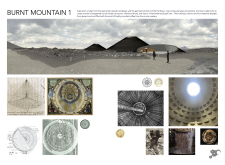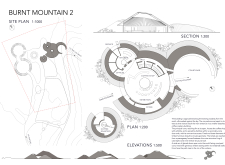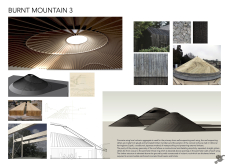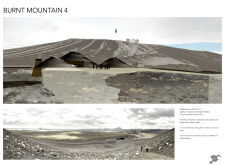5 key facts about this project
The project serves multiple functions, including communal gathering spaces, a coffee roastery, and areas for cultural exchange. The design incorporates glazed openings, or oculi, enabling natural light to penetrate interior spaces, thus enhancing the users' experience and fostering a connection with the surrounding landscape.
Unique Integration of Natural and Cultural Elements
The Burnt Mountain project distinguishes itself through its innovative use of materials and design approaches that resonate with the Icelandic culture and natural environment. The exterior is clad in fire-blackened Suyaki timber, which not only enhances durability but also reflects traditional Japanese architectural techniques that align with local practices. This material choice provides a protective layer against the elements while simultaneously offering an aesthetic that is both contemporary and rooted in tradition.
The use of locally sourced volcanic aggregate in the concrete walls strengthens the project's relevance to its geographical context. The distinctive conical forms are strategically tilted and sliced, leading to diverse interior environments that cater to various functions, from intimate gatherings to larger communal events. The interplay of these forms with the landscape reinforces the project's commitment to sustainability and contextual awareness.
Innovative Architectural Features and Design Outcomes
The architectural design of Burnt Mountain includes several key features that contribute to both its functionality and aesthetic appeal. The central open space acts as a meeting point, fostering community interaction. The careful arrangement of the conical structures allows for varied spatial experiences, emphasizing both privacy and openness where appropriate.
The integration of oculi in the conical designs promotes an engaging atmosphere, with light illuminating interior spaces at different times throughout the day. These design elements encourage visitors to engage with the setting actively, highlighting the importance of natural light and environmental interaction in the architectural experience.
For further insights into the Burnt Mountain project, readers are encouraged to explore the architectural plans, sections, and designs that illustrate the thoughtful consideration behind each element. This exploration provides a deeper understanding of the architectural ideas that contribute to the project's success within its unique context.


























